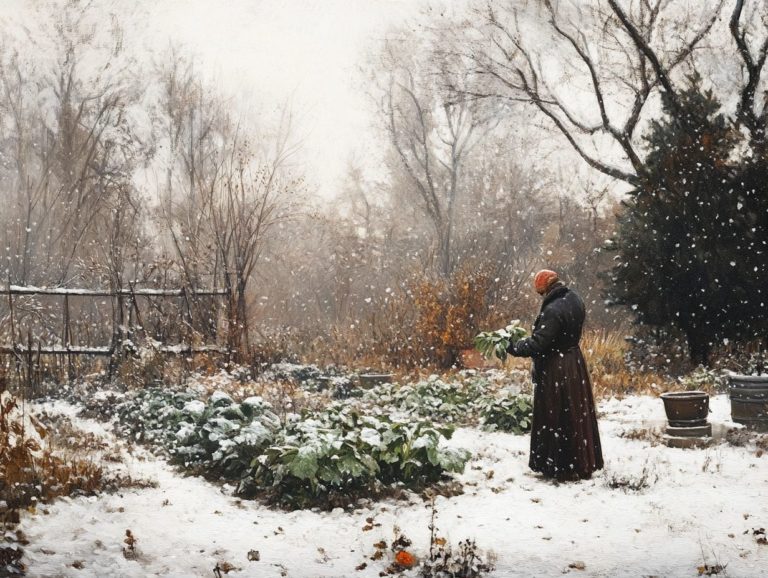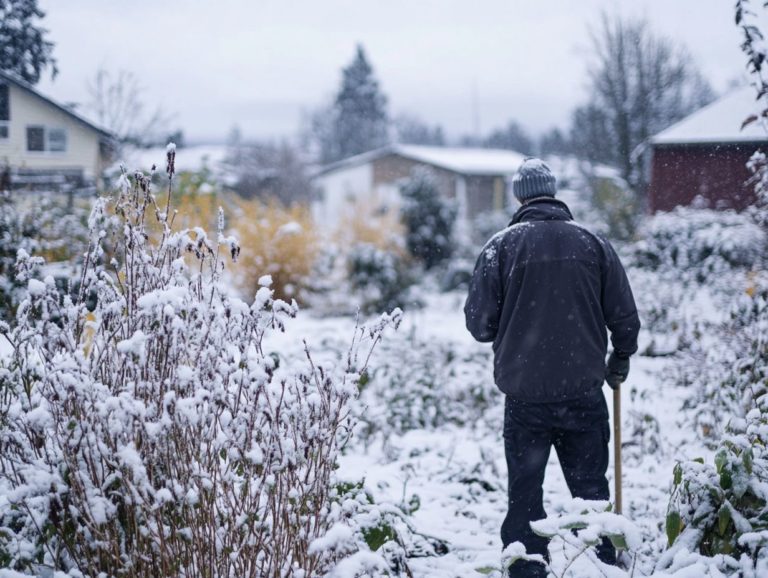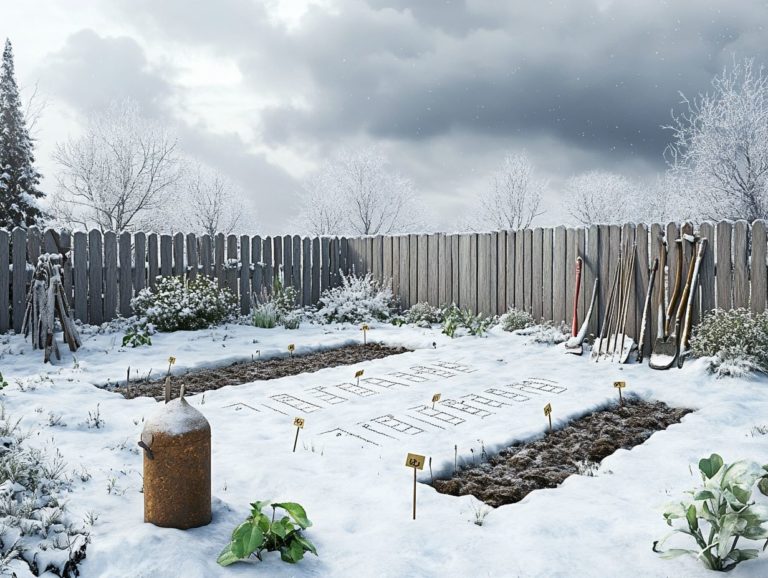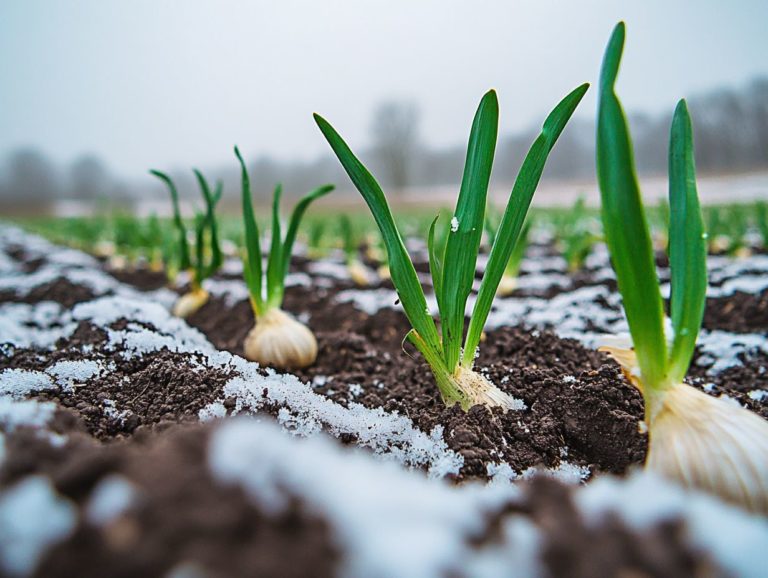Seasonal Gardening Checklist for Cold Climates
As winter draws near, you might feel tempted to hang up your trowels and stow away your gardening gloves. However, your cold-climate garden holds many possibilities! From prepping your soil for the frosty months ahead to planting robust vegetables and safeguarding your plants from frost, there s plenty you can do to ensure your garden thrives.
Get ready to dive into a fun checklist of winter gardening tasks that will keep your garden thriving! Embrace the beauty of winter gardening and uncover the secrets to keeping your outdoor space vibrant and productive all year long!
Contents
- Key Takeaways:
- 1. Preparing Your Garden for Winter
- 2. Planting Cold-Weather Vegetables
- 3. Protecting Your Plants from Frost
- 4. Mulching and Composting
- 5. Pruning Trees and Shrubs
- 6. Cleaning and Storing Garden Tools
- 7. Planning for Spring Planting
- 8. Maintaining Your Garden During Winter
- 9. Building Cold Frames or Greenhouses
- 10. Winter Pest Control
- 11. Winter Watering Tips
- 12. Winter Plant Care Tips
- 13. Preparing for Snow and Ice
- 14. Winter Garden Decorations
- 15. Winter Gardening Activities for Kids
- What Are the Benefits of Seasonal Gardening in Cold Climates?
- Frequently Asked Questions
- What is a seasonal gardening checklist for cold climates?
- Why is it important to have a seasonal gardening checklist for cold climates?
- What tasks should be included in a seasonal gardening checklist for cold climates?
- When should I start following my seasonal gardening checklist for cold climates?
- Can I customize my seasonal gardening checklist for cold climates?
- What are the benefits of using a seasonal gardening checklist for cold climates?
Key Takeaways:
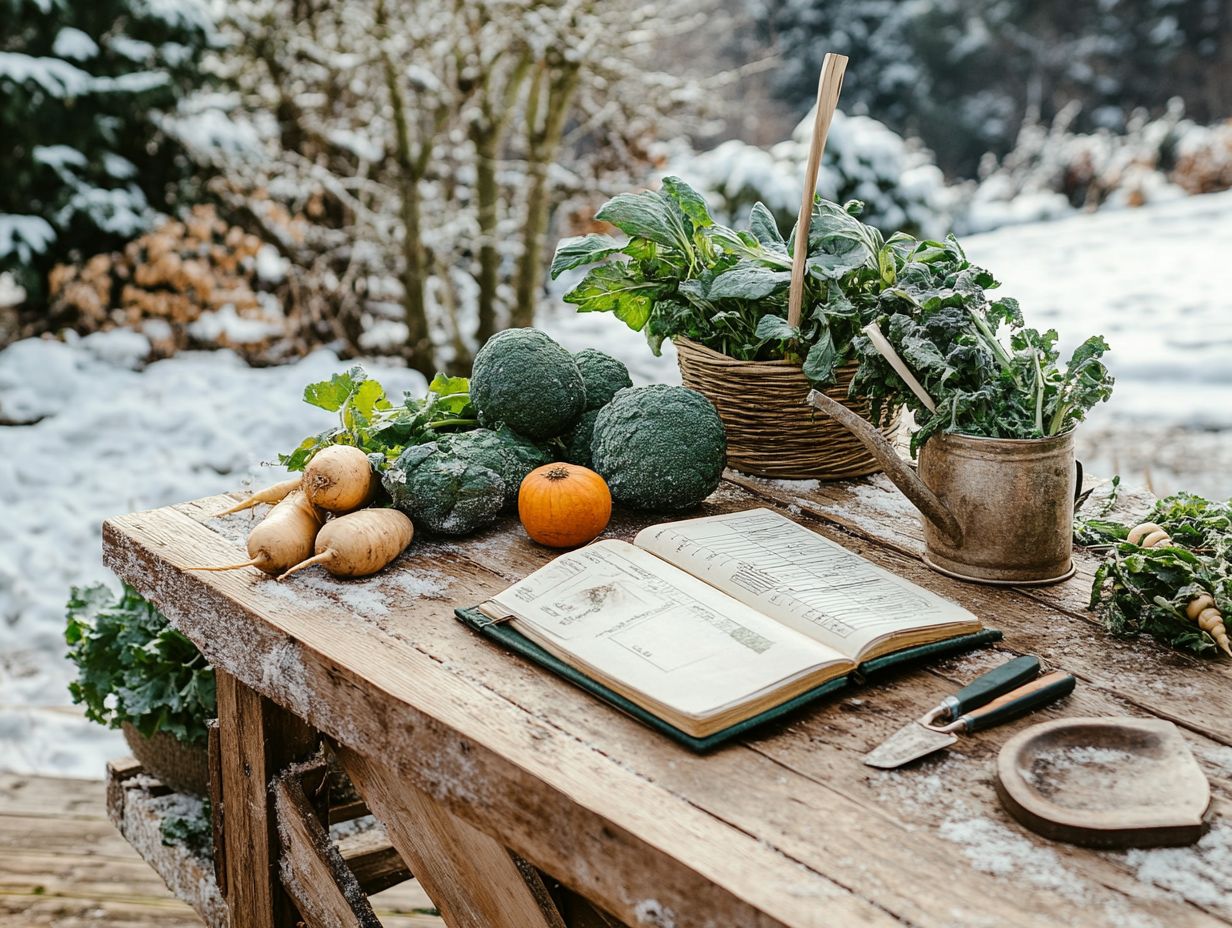
- Don’t neglect your garden in the winter! Prepare it for the colder months by adding a protective layer of material (mulching), shielding plants from frost, and planning for spring planting.
- Take advantage of the cold weather by planting vegetables that thrive in cooler temperatures, like carrots and spinach. Using cold frames or greenhouses can extend your growing season. Consider late-season planting for a unique twist!
- Keep your garden tools clean and organized. Remember to maintain winter watering and pest control. Involve kids in winter gardening activities to make it a fun and educational experience for the whole family.
1. Preparing Your Garden for Winter
Preparing your garden for winter involves essential tasks designed to protect your plants and soil. This is especially crucial if you’re in a colder climate, where winter gardening needs careful planning and the right tools to safeguard your plants.
Knowing what to do before the frost arrives can significantly impact your garden’s health come springtime. That’s why using a winter garden checklist is vital, regardless of your expertise.
Your checklist should include tasks like:
- Pruning perennials
- Mulching (adding a protective layer of material to keep moisture in and protect plants)
- Planting spring bulbs
Gathering the right tools like pruning shears, garden forks, and tarps is equally important to streamline your preparations. Experts like Rick Stone emphasize the value of proper plant care, offering specific techniques to protect delicate roots and prevent soil erosion.
Resources from Our Stoney Acres provide additional insights on essential soil management practices to maintain nutrient levels throughout winter.
By taking these steps, you ll ensure your garden is ready to bloom beautifully when the warm months return. Get started on your winter gardening tasks today!
2. Planting Cold-Weather Vegetables
Late-season planting can be rewarding, especially when you focus on cold-weather vegetables like carrots, spinach, and kale, which flourish even as temperatures dip.
These resilient varieties not only endure the chill but often enhance their flavor after a frost, making them a delightful addition to your winter meals. By planting late, you can extend your harvest season and provide essential nutrients during the colder months.
It s crucial to sow your seeds in well-prepared soil, allowing them ample space for healthy growth. Using mulch can help retain warmth and moisture in the soil. A protective cover will shield your emerging seedlings from biting winds.
By taking these thoughtful steps, you can enjoy a bountiful late-season harvest, fully embracing the unique advantages that cool-weather gardening offers while leveraging grow lights for optimal growth. Get started on your late-season planting today!
3. Protecting Your Plants from Frost
Protecting your plants from frost is essential for keeping your garden healthy throughout the winter months. By employing winter protection methods such as horticultural fleece, cloches, and burlap, you can effectively shield your plants from harsh conditions.
These materials act as a barrier against the biting cold. They help to trap heat while protecting delicate foliage. To use horticultural fleece, simply drape it over your plants on particularly cold nights. Make sure it s securely fastened so it doesn t blow away.
Cloches, whether glass or plastic, should be placed over individual plants or small areas of your garden for added warmth. This method is perfect for nurturing tender seedlings.
Burlap provides a charming option, wrapping around larger plants or shrubs to deliver much-needed insulation. Keep a close eye on weather forecasts. Act quickly! Ensure your plants are wrapped up tight before any expected frosts, especially on clear nights when temperatures tend to plummet.
4. Mulching and Composting
Adding mulch and using a compost bin not only enhances soil health but is also crucial for winter gardening. These practices prevent soil erosion and shield your plants from extreme temperatures.
By creating a protective barrier between the soil and harsh winter elements, you help maintain a more stable soil temperature. This stability allows beneficial organisms to thrive just beneath the surface.
Applying organic mulch such as straw, dried leaves, or wood chips can significantly aid in moisture retention. This reduces how often you need to water during dry spells.
Composting enriches your soil with essential nutrients while improving its structure for better drainage. In winter, consider eco-friendly options like shredded newspaper or cardboard for your compost bins. This choice optimizes waste and provides insulation, supporting your commitment to sustainable gardening practices.
5. Pruning Trees and Shrubs
Pruning your trees and shrubs during your seasonal gardening tasks encourages healthy growth and sets the stage for a spectacular spring. This significantly uplifts your garden’s overall beauty and vitality.
To achieve the finest results, wielding the right tools is crucial. Sharp pruning shears, loppers, and a saw ensure clean cuts that prevent unnecessary damage to your beloved plants. Remember, proper cleaning gardening tools is just as important to keep them in prime condition.
Timing is key most species thrive when pruned in late winter or early spring, just before new growth emerges. Certain plants, like hydrangeas or roses, have specific pruning schedules to unlock their fullest blooms.
By regularly engaging in pruning, you can effectively remove dead or diseased branches. This minimizes the risk of infection and fosters a more resilient plant. Familiarizing yourself with these best practices will amplify growth while keeping your plants healthy and vibrant.
6. Cleaning and Storing Garden Tools
Cleaning and storing your essential garden tools at the end of the season is the secret to keeping them sharp and ready for action come spring!
A systematic approach safeguards your investment and boosts your gardening efficiency when the warmer months roll back around.
- Start by inspecting each tool for any signs of wear or damage that might need attention before tucking them away.
- Then, give them a thorough cleaning using a scrub brush and soapy water to eliminate dirt, sap, and rust.
- Once they re dry, apply a light coat of oil to create a protective barrier against moisture a crucial step as winter looms.
- Finally, store them properly in a dry, sheltered spot to prevent rust and extend the life of your garden tools. This ensures they re in top-notch condition when it s time to dive into your spring garden.
7. Planning for Spring Planting
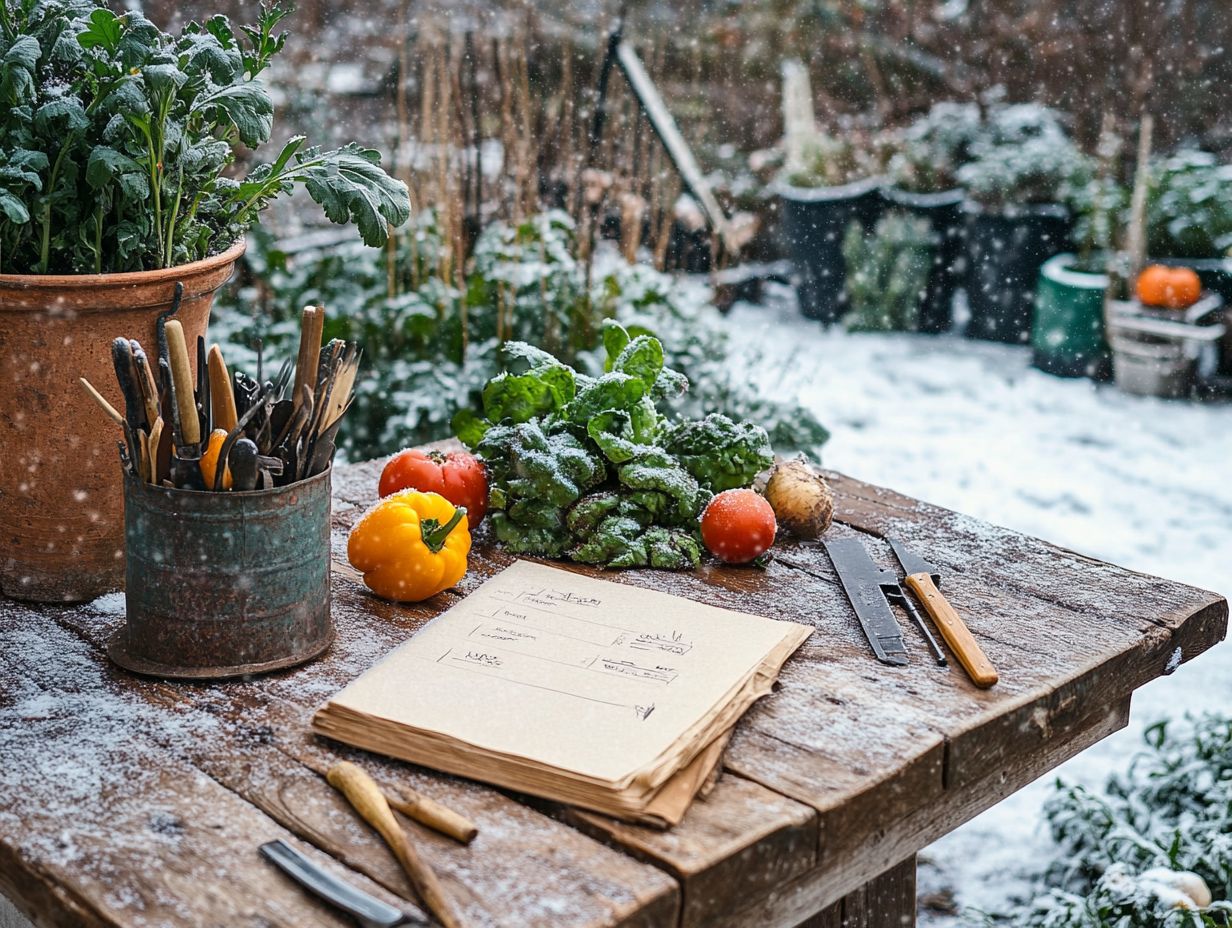
Planning for spring planting during the winter months offers a perfect chance to evaluate your gardening resources and create a detailed winter garden checklist. Understanding what is cold-climate gardening can enhance this preparation, ensuring success in the upcoming planting season.
Use this time to reflect on what worked well in past seasons and what didn t. This self-reflection can lead to much more fruitful results. Consider vital factors like soil temperature and local frost dates, as these elements significantly influence your optimal planting timeline.
Crop selection is equally important. Choosing varieties that thrive in your specific climate will enhance both yield and resilience.
Leveraging resources such as garden planners, planting calendars, and local extension services can provide valuable insights tailored to your region. By doing so, you ll ensure you are well-prepared to make this spring your most successful gardening season yet!
8. Maintaining Your Garden During Winter
Winter gardening can be exciting and rewarding! Maintaining your garden during winter might seem daunting, but with regular weeding and a few winter plant care tips, you can keep your garden thriving and poised for a spectacular spring bloom.
To achieve this, implement specific strategies to ensure your plants stay healthy throughout the colder months. Start by keeping a close eye out for any weeds that could disrupt growth, and remove them promptly before they take root.
As temperatures dip, monitoring plant health becomes crucial. Look for any signs of stress or disease that might be aggravated by winter conditions.
Proper watering routines are also vital during this season. Overwatering can lead to root rot, while underwatering risks drying out your plants. Strive for a careful balance to help them withstand the frost and emerge vibrant when spring arrives.
9. Building Cold Frames or Greenhouses
Building cold frames or greenhouses can significantly extend your gardening season, offering a controlled environment for your plants even in the coldest months. When enhanced with grow lights, you set the stage for optimal growth!
These structures not only shield delicate seedlings from frost but also cultivate a warmer microclimate, encouraging you to plant and harvest earlier. Cold frames effectively manage temperatures and humidity levels, allowing a wider variety of plants that usually struggle in colder conditions.
Incorporating grow lights into your setup can further elevate your gardening game, especially during winter. These lights mimic sunlight and promote photosynthesis, giving your plants the boost they need. Position the grow lights above your seedlings at the right distance to ensure they bask in adequate light without the risk of overheating.
Regularly adjusting both the lights and ventilation will optimize conditions, leading to a thriving indoor garden that flourishes throughout the season. Take action now and enjoy your gardening journey!
10. Winter Pest Control
Implementing effective winter pest control measures is crucial for safeguarding your garden from pests that thrive in the colder months. Choosing eco-friendly products minimizes your environmental impact and aligns with modern gardening resources.
As temperatures dip, insects like aphids, spider mites, and mealybugs may seek refuge in your garden. It’s essential to adopt preventative strategies. You can use natural pesticides like neem oil and insecticidal soaps to deter these unwelcome guests without harming beneficial organisms. You can also use physical barriers like row covers to protect your plants. Remember, maintaining proper sanitation by removing debris will reduce potential hiding spots for pests.
Regularly inspecting your plants for signs of pest activity allows you to intervene early, ensuring your winter greenery remains healthy and vibrant throughout the season.
11. Winter Watering Tips
Understanding winter watering tips is essential for maintaining your plants’ vitality, especially as you prepare your watering system to deliver moisture during dry, cold spells. Make sure to prepare your irrigation system to avoid any issues.
Even in winter, your plants can experience dehydration, so adjusting your watering schedule becomes crucial. Regularly check the soil moisture because root zones can dry out even with a frozen surface. Water less frequently perhaps every few weeks and ensure that the water penetrates deeply to nourish the roots. Consider using efficient techniques like soaker hoses or drip irrigation to minimize waste while maximizing effectiveness.
Don’t forget to winterize your irrigation system! Drain any standing water to prevent freezing, which will help protect your pipes and connectors from damage.
12. Winter Plant Care Tips
Winter plant care tips are vital for protecting your vulnerable plants and ensuring their survival through the chilly months. For gardeners like you, staying vigilant and proactive is essential. Remember to move vulnerable plants to warmer spots when necessary.
Delicate plants like ferns, tropical flowers, and certain shrubs struggle in lower temperatures. Methods like mulching can insulate roots. You can drape frost cloths over your plants or relocate potted plants to more sheltered spots to protect them from harsh winds and freezing conditions.
As the seasons shift, keeping a close eye on soil moisture is crucial. Dormant plants may need less frequent watering, while those still actively growing may require adjustments to their watering schedules. By adapting your care strategies to the weather patterns, you can significantly boost your plants’ resilience this winter.
Start implementing these tips today to ensure your garden thrives all winter long!
13. Preparing for Snow and Ice
Preparing for snow and ice is crucial in winter gardening; the right protection strategies can save your plants and structures from winter s harsh embrace. Ensure you have winter protection methods in place.
To ensure your garden flourishes through even the coldest months, you must take proactive measures to shield your precious flora.
Start by draping sensitive plants in burlap or frost cloth. This not only serves as a protective barrier against biting winds but also allows for much-needed air circulation. A generous layer of mulch will work wonders, insulating the soil and helping retain moisture, which keeps those roots cozy and protected from freezing temperatures.
If a heavy snowfall is on the horizon, take a moment to gently brush off any snow piling up on branches to prevent potential breakage. Installing windbreaks can create a buffer against strong winds, providing you with peace of mind as winter settles in.
14. Winter Garden Decorations
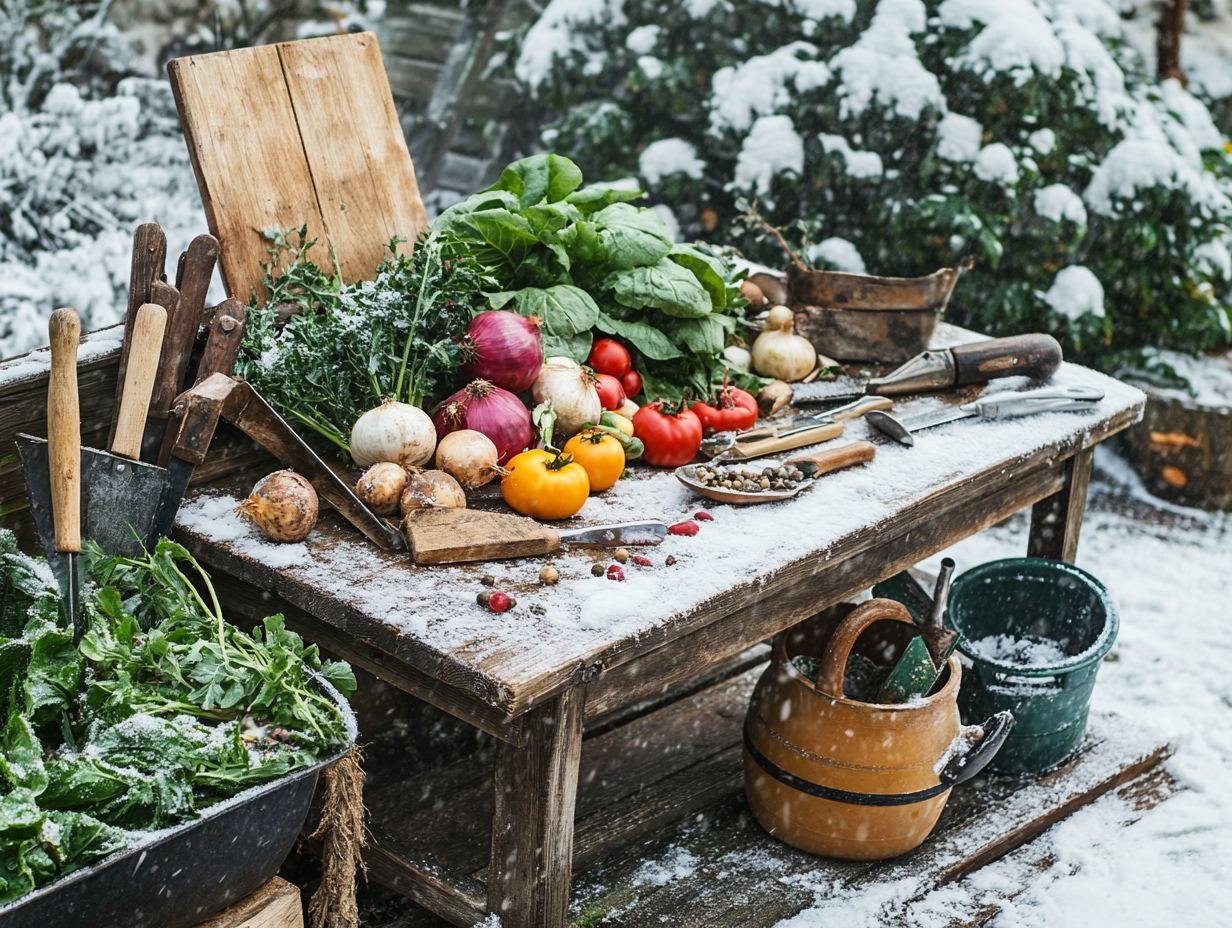
Incorporating winter garden decorations can truly breathe life and joy into your outdoor space, even in the depths of winter. Thoughtful additions like bird feeders and bird baths attract wildlife during those chilly months, turning your garden into a vibrant haven.
These elements enhance the visual appeal of a stark winter landscape and provide essential resources for birds seeking sustenance in frigid temperatures. Picture adding colorful ornaments, such as hanging lanterns or eye-catching pinecone feeders, to create a festive atmosphere that brightens even the dreariest of days.
By including native plants that bear winter berries, you invite a variety of birds and small mammals into your garden, fostering a lively ecosystem.
By crafting these inviting spaces, you cultivate a sanctuary that benefits both wildlife and your own aesthetic enjoyment during the cold season.
15. Winter Gardening Activities for Kids
Engaging in winter gardening activities for kids offers a delightful and educational opportunity to inspire a genuine love for nature and gardening, all while providing hands-on experiences even during the chillier months. Consider incorporating a winter garden checklist to make it more fun.
You might find that simple tasks like crafting bird feeders, planting winter herbs indoors, or starting a small vegetable garden can ignite curiosity and spur creativity. Parents and children can collaborate to design their garden space, imparting invaluable lessons about responsibility and teamwork.
Get ready for cozy indoor fun that sparks unforgettable family memories as you bond over planting seeds and discussing the wonders of growth.
By weaving in storytelling about plants and ecology, kids not only absorb knowledge but also develop a richer understanding of their environment. These joyful activities have the potential to nurture a lifelong appreciation for gardening.
What Are the Benefits of Seasonal Gardening in Cold Climates?
Seasonal gardening in cold climates offers many advantages. By understanding planting schedules in cold areas, you can customize your gardening practices for better productivity and enjoy fresh produce, even in harsh conditions.
By employing strategies like cold frames and hoop houses, you can create small areas with different climate conditions than their surroundings to protect delicate plants from frost. Companion planting helps control pests naturally, allowing you to reduce the need for chemical interventions.
Choosing cold-resistant crops means you can grow vegetables like kale and radishes, which thrive in lower temperatures. This approach not only diversifies your harvest but also makes your gardening more sustainable and fun!
Ultimately, embracing seasonal gardening builds resilience. You can relish the fruits of your labor year-round, regardless of the chill in the air.
What Are the Common Challenges of Gardening in Cold Climates?
Gardening in cold climates presents unique challenges, including shorter growing seasons, extreme weather conditions, and the need for specialized knowledge about plant hardiness and care. To tackle these issues effectively, check out essential gardening apps for cold climates. Always refer to a gardening checklist to stay organized.
As a gardener, you often face issues like unexpected frost damage, which can jeopardize your delicate seedlings. You should also consider the heavy weight of snowfall, as it can compromise structures such as greenhouses or cold frames.
Maintaining soil health becomes crucial because the cycles of freezing and thawing can lead to compaction and erosion. To tackle these challenges, using row covers can protect your plants from frost, while raised beds can enhance drainage and improve soil quality.
Incorporating mulches not only insulates the ground but also retains moisture this is invaluable when spring finally arrives. Prepare now to conquer seasonal challenges! With the right strategies, you can create a thriving garden, no matter how tough the climate gets.
What Are the Best Plants for Winter Gardening in Cold Climates?
Identifying the best plants for winter gardening in cold climates is crucial for your success. Varieties like kale, spinach, and certain winter crops stand resilient against icy temperatures, proving to be reliable choices.
You might also consider hardy herbs such as thyme and oregano; they thrive in frosty conditions and require minimal care.
Root vegetables like carrots and beets not only offer a delightful sweetness that enhances with cold exposure but also make for a rewarding winter harvest.
Understanding your local climate is essential. Selecting varieties that align with your region’s dates when frost typically occurs and temperature ranges will significantly elevate your gardening experience.
For example, if you’re in a milder area, you could experiment with more delicate greens, while those facing harsher climates should focus on hardier species to ensure a fruitful winter yield.
How Can You Extend the Growing Season in Cold Climates?
Extending the growing season in colder climates is entirely within your reach through various gardening techniques, such as utilizing cold frames, greenhouses, and carefully planned planting schedules.
By employing these methods, you can create a more favorable environment for your plants, enabling them to flourish even as temperatures dip. For example, cold frames serve as mini-greenhouses, capturing warmth and protecting young seedlings from frost, while strategic planting ensures that specific varieties mature before the chill arrives.
Row covers protect delicate crops against unexpected temperature shifts. Imagine enjoying fresh vegetables well into winter! Early planting and late harvesting can give you a delicious advantage, allowing you to relish a longer bounty of fresh produce.
What Are the Essential Tools for Winter Gardening?
Having the right tools for winter gardening is crucial for successfully tackling various tasks and ensuring your plants thrive during the colder months. These tools don’t just simplify your work; they also safeguard your plants against harsh winter conditions.
- A sturdy shovel is essential for digging and moving soil.
- A reliable pruning saw becomes essential for maintaining trees and shrubs.
- Investing in a winter cover for your garden beds can protect your young plants from frost and biting winds.
To keep these tools in peak condition, it s vital to clean them after each use, lubricate any moving parts, and store them in a dry place to ward off rust. By prioritizing proper maintenance, you ll ensure their longevity and efficiency, allowing you to focus more on nurturing your plants and less on wrestling with equipment issues.
Frequently Asked Questions
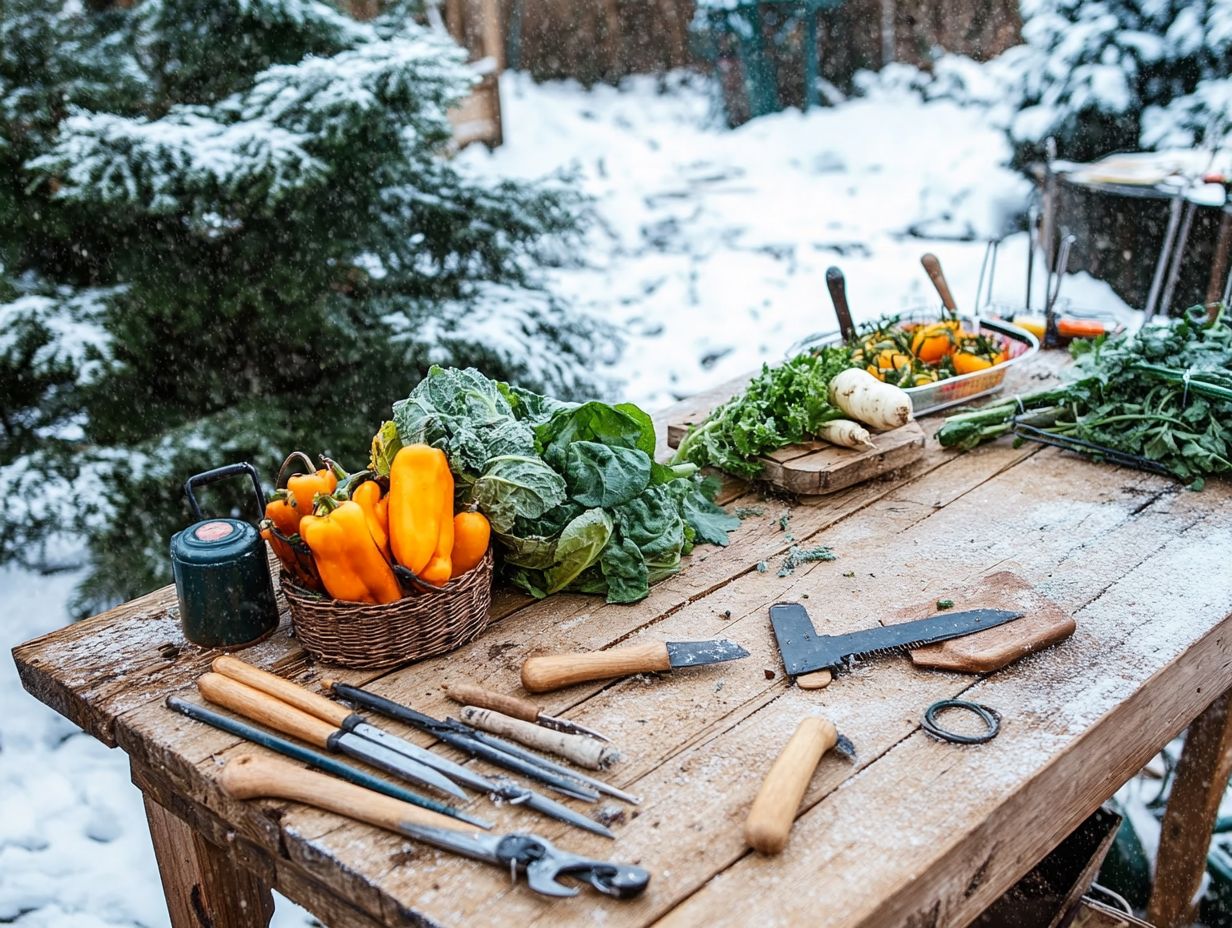
What is a seasonal gardening checklist for cold climates?
A seasonal gardening checklist for cold climates is a list of tasks and reminders for gardeners to follow during each season to maintain a successful garden. It includes important tasks such as planting, pruning, and protecting plants from harsh winter weather.
Why is it important to have a seasonal gardening checklist for cold climates?
In cold climates, the weather can greatly impact the success of a garden. By following a seasonal gardening checklist and updating your cold-climate gardening resources, gardeners can ensure that their plants are well taken care of and protected, leading to a more successful and thriving garden.
What tasks should be included in a seasonal gardening checklist for cold climates?
A seasonal gardening checklist for cold climates should include tasks such as preparing the soil, planting cold-hardy plants, mulching, and protecting plants from frost. For a comprehensive approach, refer to the seasonal soil preparation checklist for gardens to ensure your garden thrives.
Start your winter garden today and enjoy fresh produce even in the cold!
When should I start following my seasonal gardening checklist for cold climates?
Start using your seasonal gardening checklist in early spring for a spring/summer garden. For a fall/winter garden, begin in late summer or early fall, keeping in mind the challenges of cold-climate gardening.
Can I customize my seasonal gardening checklist for cold climates?
Yes! Every garden is unique, so tailor your checklist to meet your needs. Feel free to add or remove tasks to ensure your garden gets the care it deserves.
What are the benefits of using a seasonal gardening checklist for cold climates?
A seasonal gardening checklist saves you time and effort by providing a clear plan. Following it can lead to a thriving garden filled with healthy plants!


